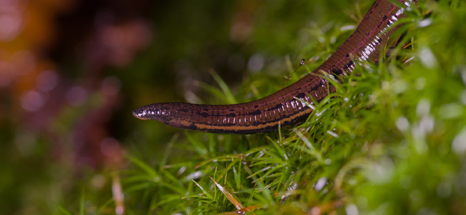 Hallowe’en is traditionally a time when creepy creatures thrive as darkness descends but for bloodsuckers in the New Forest life is not so rosy.
Hallowe’en is traditionally a time when creepy creatures thrive as darkness descends but for bloodsuckers in the New Forest life is not so rosy.
With three jaws each containing 100 sharp teeth and the ability to consume up to 10 times their body weight in blood, it is easy to see how the leech has earned its spine-chilling reputation.
But life for the European medicinal leech (Hirudo medicinalis) is far from easy and the species is at risk in the UK. In the New Forest, one of its strongholds, it has previously been found in just four ponds near Brockenhurst and Lymington.
Now, a new survey of this leech species has shown their continued vulnerability, with numbers growing in two of the ponds, but down at a third pond and none at all found in the fourth pond.
The survey was carried out as part of the New Forest Higher Level Stewardship scheme by an independent expert specialising in freshwater ecology. The New Forest HLS Scheme is a 10-year agreement with Natural England that is held by the Verderers of the New Forest. The scheme is managed by them in partnership with the Forestry Commission and the New Forest National Park Authority.
The European medicinal leech has been in decline across the whole of the UK for many years, with a number of populations lost altogether. In fact it has been declared extinct in the UK twice in the 20th century but has subsequently been rediscovered. Current estimates suggest there are 20 isolated populations remaining in the UK, mainly in the New Forest, Dungeness, south Wales and the Lake District (Elliot and Dobson, 2015).
With so few members of this species of leech left in the New Forest and a decline across the country as a whole, work to increase their numbers is vital.
As well as sensitive management of the Open Forest, the population could also be helped by careful reintroduction to safeguard the future of the species. This is just one possible option and ponds will be checked for their suitability before any reintroduction is considered.
Sarah Oakley, HLS Ecologist at the Forestry Commission, said: ‘Monitoring rare and vulnerable species across the New Forest is a crucial and important aspect of the HLS scheme. It helps us to understand how our forest management affects their population and what more we can do to help.
‘By surveying our local leech population we can see which sites need protecting and can make plans to preserve and boost the number of leeches in the coming years.’
To find out more about the work of the HLS scheme in the New Forest visit www.hlsnewforest.org.uk.
– Ends –
Photo editor:
A medicinal leech in the New Forest by Neil Phillips.
Notes to editors:
1. The role of the Verderers of the New Forest is to protect and administer the New Forest’s unique agricultural commoning practices; to conserve its traditional landscape, wildlife and aesthetic character, including its flora and fauna, peacefulness, natural beauty and cultural heritage; and to safeguard a viable future for commoning. www.verderers.org.uk
2. The Forestry Commission is the government department responsible in England for protecting, expanding and promoting the sustainable management of woods and forests and increasing their value to society and the environment. www.forestry.gov.uk/england-about-us
England’s Woods and Forests are cared for by Forest Enterprise England, an agency of the Forestry Commission. www.forestry.gov.uk/englandsforests
For more information, visit www.forestry.gov.uk/newforest
3. Natural England is the government’s advisor on the natural environment. Established in 2006 our work is focused on enhancing England’s wildlife and landscapes and maximising the benefits they bring to the public. www.naturalengland.org.uk
4. The Environmental Stewardship Scheme, of which HLS is one strand, is administered by Natural England, on behalf of Defra, and funds farmers and land managers throughout England to deliver effective environmental management on their land.
The objectives of Environmental Stewardship are to:
- Maintain and enhance landscape quality and character
- Protect the historic environment and natural resources
- Conserve biodiversity.
- Promote public access and understanding of the countryside
The ES scheme is now closed to new applicants and has now been succeeded by the Countryside Stewardship scheme
5. The New Forest National Park Authority works with partners to conserve and enhance the natural beauty, wildlife and cultural heritage of the National Park and to promote opportunities for understanding and enjoyment of its special qualities. It also has a duty to foster the social and economic well-being of local communities within the Park. www.newforestnpa.gov.uk
Media Contact:
Esta Mion, Communications Manager, Forestry Commission – South England Forest District. esta.mion@forestry.gsi.gov.uk / 07900 137 957.